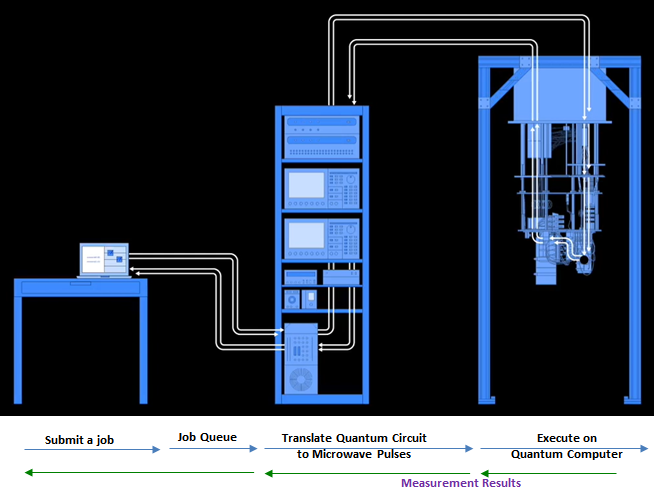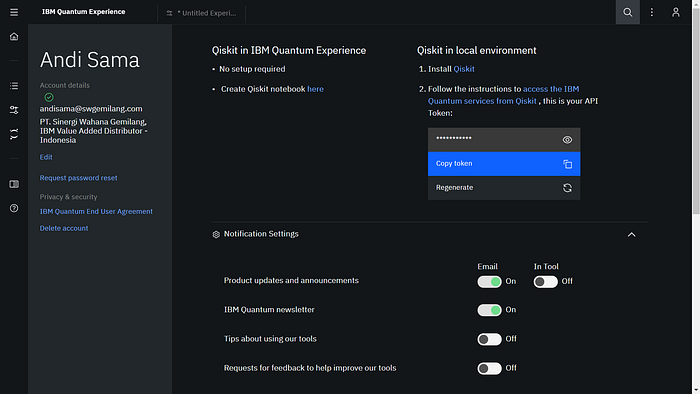My Journey to the Exciting World of Quantum Computing — A Novice's Perspective
Exploring here and there "simultaneously," like being in the Quantum Superposition
Andi Sama — CIO, Sinergi Wahana Gemilang, with Cahyati S. Sangaji
In Summary
- Getting trustable sources from leading Industry Experts and Universities is important (including attending conferences wheneveer available), especially in a new dynamically changing field like Quantum Computing.
- Getting certified is one way to prove formally that we have reached certain milestones.
- Clarifying challenging and complex concepts by consulting with different experts would be invaluable in building our understanding gradually.
- Sharing to others through discussions, webinars, lectures, and written articles would better sharpen our understanding by being challenged through different perspectives, including getting feedbacks for future improvements. My interest in Quantum Computing started in May 2016 when IBM launched IBM Quantum Experience, the universal quantum computer platform, accessible from the IBM Cloud starting with just five qubits (it has expanded to 433 qubits since November 2022 and aims for 1,121 qubits by the end of 2023 and 100,000 qubits within the next ten years). My curiosity was tickling. This new area of advanced and emerging technology sounds exciting and worth exploring.
This is an updated article, from the previously published article in January 2021 (Andi Sama, et al., 2021), “My Journey to Quantum Computing.”

I quickly explored the platform for just a few weeks when it was still based on QASM, the Quantum Assembly language, then left it untouched until it restarted again in early 2020. This time, it had improved so much as Qiskit, the higher-level quantum library that can be used in Python. Qiskit started to be available as open-source since its introduction in 2017.

IBM has always been somewhere in my life, both directly and indirectly. When I was just in my 4th year of completing my bachelor's degree, I started from campus recruitment and then spent ten years in IBM Indonesia & Asia Pacific. For the next ten years, I worked for an IBM Business Partner. And now, since 2010, for Sinergi Wahana Gemilang, an IBM Value Added Distributor in Indonesia.


Early exposure to advanced & emerging technologies has been one of my realized passion with IBM and exposure to open sources in the last ten years. Cloud, big data, Internet of Things (IoT), blockchain, and Artificial Intelligence have been the key drivers in the 2010s. Quantum Computing is an exciting new emerging technology area, promising a leap forward to 2030 and beyond.
Since restarting to learn Quantum Computing in 2020, Quantum Computing has been hard. My educational background in computer engineering (bachelor's degree), computer science, and business administration (master's degrees) do not provide enough foundation knowledge for learning Quantum Computing.
I think it is safe to say that “the more I think I understand the quantum mechanics three basic concepts: superposition, entanglement and interference,” the more I do not understand the concept.
It’s like being in a superposition state, in which when not being measured, the state can be in the probability of “50% understand” and “50% does not understand” at the same time.Experts in the Field
It's good to have someone to ask when exploring new things outside our focus areas. Their expertise and experiences in the field can guide us back to the right path, especially when we feel lost and need help understanding some basic theoretical and practical concepts.
Inspired by the fact when I started learning Deep Learning, I started doing the same for Quantum Computing. Deep Learning is a subfield of Machine Learning within Artificial Intelligence in Computer Science.
For Deep Learning, in addition to exploring leading open-source frameworks such as Tensorflow, Keras, fast.ai, and Pytorch, I followed a few graduate online courses from leading Universities like Stanford and MIT, including consulting a friend who has a Ph.D. in this area and following local graduate courses in Indonesia, like Binus University.
Sure, forums and group discussions on the Internet help. However, getting help and feedback from experts in the field proves invaluable to our learning journey. A friend of mine, Suryadiputra Liawatimena, recently introduced me to one of his doctoral supervisors, Agung Trisetyarso.
One of Agung's doctoral supervisors was Professor Rod Van Meter at Keio University, Japan. His research focuses on distributed quantum computing and post-Moore's Law computer architecture. In May 2018, Keio University was declared the IBM Q Hub for Asia, authorized to access current and future IBM Q Systems.

Lectures and Talks
For Quantum Computing, I started with the basic ones, as I need an educational background in Classical Physics. I explored many online sources related to Quantum Mechanics and Quantum Computing to understand specific topics from different perspectives.
I have only sometimes completed all the lecture materials sequentially from the beginning to the end. Occasionally, I quickly watched the specific materials (videos) I needed clarification on and then moved to the next. Once in a while, revisiting the same materials a few times helped increase my understanding of the specific sub-topics.
Some of the references in the lectures and talks that I have followed are as follows:
- Brian Greene, 2022, "Einstein and the Quantum: Entanglement and Emergence," World Science Festival.
- Advanced Maths, 2020–2021, "Quantum Computing."
- DoS — Domain of Science, 2021, "The Map of Quantum Computing — Quantum Computers Explained."
- Fernandez-Combarro Alvarez, Elias, 2020, "A practical introduction to quantum computing: from qubits to quantum machine learning and beyond," CERN, November-December.
- IBM, 2020, "Qiskit Global Summer School," July 20–31, 2020.
- John Preskill, 2021, "Quantum Computing — 40 Years Later & 4 Years Later", Q2B 2021, December.
- John Preskill, 2018, "Quantum Computing in the NISQ era and beyond," Cornell University.
- Michael Nielsen, 2011, "Quantum Computing for the Determined."
- Qiskit Community Team, 2020, "Learn Quantum Computation using Qiskit," Qiskit.org, IBM.
- Qiskit YouTube Channel, 2020, "Quantum Information Science Kit," Qiskit.org, IBM.
- Ryan O'Donnell, 2018, "Quantum Computation and Quantum Information," Carnegie Mellon Course 15–859BB, Fall 2018.
- The University of Chicago, 2021, "Quantum Computing for Everyone."
- Umesh V. Vazirani, 2018, "Quantum Computation," University of California, Berkeley.
Certifications & Digital Badges
It is not my original intention to get certifications in Quantum Computing. However, during the journey throughout 2020, recent research discussions were provided through accreditation. Delft University in the Netherlands offered a good one, so I took their two current courses through edX and got myself certified in Quantum Internet.
- Andi Sama, 2020a, "QTM1x: The Quantum Internet and Quantum Computers: How Will They Change the World?" Delft University of Technology.
- Andi Sama, 2020b, "QTM3x: Architecture, Algorithms, and Protocols of a Quantum Computer and Quantum Internet", Delft University of Technology.
IBM has a Digital Quantum Badge program. Unfortunately, the program is not available externally other than for IBM Employees.

In partnership with MIT, IBM has been running a few round sessions on the "Introduction to Quantum Computing" course to educate the world on Quantum Computing. This Qubit by Qubit program has been available for free, including for enthusiasts in their final year of senior high school.
- QubitxQubit, 2021, "Quantum Summer Camps, Courses & Research Opportunities."
A colleague of mine in Sinergi Wahana Gemilang, Cahyati Supriyati Sangaji, completed the 8-month program in May 2021. In late 2021, IBM opened select digital badge programs externally, and she achieved the advanced badge for IBM's Quantum Challenge in the Fall of 2021.
The following are snapshots of a few IBMers who have acquired the IBM Quantum badges, pushing forward to learn about the future's exciting emerging technology at its early stages. Imelda Muti of IBM Indonesia, and Jing Yi Chan — the former IBM Quantum Ambassador for the Asia Pacific.


Published Articles
I also published a few articles through medium.com. Sharing also allows me to receive constructive comments and critiques as I progress.
Recent ones include exploring a hybrid Classical-Quantum Machine Learning (QML) to train deep-learning neural network layers by quantum means. The selected use case is the classic Image Classification, whether a person is wearing a mask or not wearing a mask.


SWG Insight quarterly editions have included the following articles. The purpose has always been to spread the knowledge and experience for IBM Business Partners and customers and prepare for the arrival of the Quantum Computing era in Indonesia.
- Andi Sama, Cahyati S. Sangaji, 2021, "Embarking on a Journey to Quantum Computing — Without Physics Degree."
The article serves as an opening article, pointing to six articles on the introduction to quantum computing:
- Andi Sama, Cahyati S. Sangaji, 2021, "Qubit, An Intuition #1 — First Baby Steps in Exploring the Quantum World."
- Andi Sama, Cahyati S. Sangaji, 2021, "Qubit, An Intuition #2 — Inner Product, Outer Product, and Tensor Product."
- Andi Sama, Cahyati S. Sangaji, 2021, "Qubit, An Intuition #3 — Quantum Measurement."
- Andi Sama, Cahyati S. Sangaji, 2021, "Qubit, An Intuition #4 — Unitary Matrices for Quantum Computation."
- Andi Sama, Cahyati S. Sangaji, 2021, "Qubit, An Intuition #5 — Quantum Circuit and Reversible Transformation."
- Andi Sama, Cahyati S. Sangaji, 2021, "Qubit, An Intuition #6 — Two Famous Quantum Algorithms, Shor's and Grover Algorithms."
More articles are as follows:
- " Andi Sama, 2021, "Quantum Computing, Communication, and Sensing —
The Potentials and Commercial Applications." - Andi Sama, 2021, "Quantum Computing, Challenges & Opportunities — QCaaS, Investment, Key Industry Players & Startups, Potential Applications, Hardware, and Software."
- Andi Sama, 2021, "Star Trek and The No-Cloning Theorem."
- Andi Sama et al., 2021, "My Journey to Quantum Computing."
- Andi Sama, 2020, “Meneropong Masa Depan Quantum Computing.”
- Andi Sama, 2020, "Hello Tomorrow — I am a Hybrid QML."
- Andi Sama, 2020, “Quantum Random Number Generator (QRNG).”
- Andi Sama, 2020, "Quantum Teleportation — Demonstrate Quantum Information Teleportation with Qiskit on IBM Q."
- Andi Sama, 2020, "Hello Many Worlds in Quantum Computer — Demonstrate 2-Qubits Entanglement with Qiskit on IBM Q".
- Andi Sama, 2020, "The Race in Achieving Quantum Supremacy & Quantum Advantage."
Lecturing Experience
Sharing knowledge and experience with others would be invaluable to the learning journey. Having discussions and getting feedback during the sharing sessions further strengthens us in mastering the topics. The more we share, the more we learn.
- Andi Sama, 2021, "Quantum Computing Concept & Use-Cases," A sharing session for a State-owned Telco's Digital Business Team in Indonesia, August 2021.
- Andi Sama, 2021, "Quantum Computing: A Brief Overview — featuring IBM Quantum," Technical sharing session for IBM Indonesia Systems team and IBM select Business Partners, May 2021.
Attending International Conferences
- Andi Sama, 2022, “Quantum.Tech 2022: Next Generation Insights of Technology Innovations."
- Andi Sama, 2022, "My First 2022 Business Travel in Covid-19 Pandemic — Is it worth it?", June.
- Alpha Events, 2021, "Quantum.Tech — Commercial Applications of Quantum Computing, Communication, and Sensing," April 2021, Online.
Challenges Ahead

Exploring and learning Quantum Computing requires a paradigm shift. It will eventually be implemented in practical applications to solve some of the world's most challenging problems that are tough to solve within a reasonable time, even with the most sophisticated Classical Supercomputers.
Hands-on practical experience in emerging technologies such as Quantum Computing or related open-source tools would be invaluable in being relevant in the future.
In addition to understanding fundamental quantum computing concepts like Superposition, Entanglement, and Interference, mastering a few leading developing software frameworks and tools is also essential.
Quantum Software, Frameworks, and Libraries
Framework encapsulates many lower-level details so we can focus on solving the higher-level problems. The framework for Quantum Machine Learning or QML, like the one provided by Xanadu's Pennylane.ai, combines Artificial Intelligence with Quantum Computer capability for developing a Hybrid Classical-Quantum Deep Learning model.
Qiskit Open Source by IBM has rich quantum libraries for building various quantum applications.
Algorithms and Tools
Generic tools to master include programming languages such as Python and C++. Programming languages like the two famous Grover's and Shor's algorithms are indispensable in working with quantum algorithms. Grover's quantum algorithm is used for searching unsorted data with quadratic speedup. Shor's quantum algorithm is used for factoring large prime numbers with polynomial speedup.
In the coming years, more inventions of novel quantum algorithms with polynomial or exponential speedup are expected to increase.
Quantum Hardware
On the hardware side, scalable quantum computers' construction towards thousands and millions of qubits is still in active research in Universities or Industries. We expect substantial advancements in the 2030s and beyond. We are now in the "Early Industrial Era for Quantum Computing," according to Prof. John Preskill, an American theoretical physicist and the Richard P. Feynman Professor of Theoretical Physics at the California Institute of Technology.
In the NISQ-era (Noisy Intermediate-Scale Quantum Computer) — IBM, with the plan for 100,000 logical qubits by the next ten years, expects that 2023 to release 1,121 qubits could be the inflection point for having practical quantum computing applications (IBM has launched 433-qubit quantum computer in November 2022). Google, Xanadu, IonQ, and others have also been racing towards FTQC (Fault-Tolerant Quantum Computer). The big challenge is that a logical qubit must be built from many physical qubits to be fault-tolerant. As many as 1,000 physical qubits are needed to make one logical qubit.
